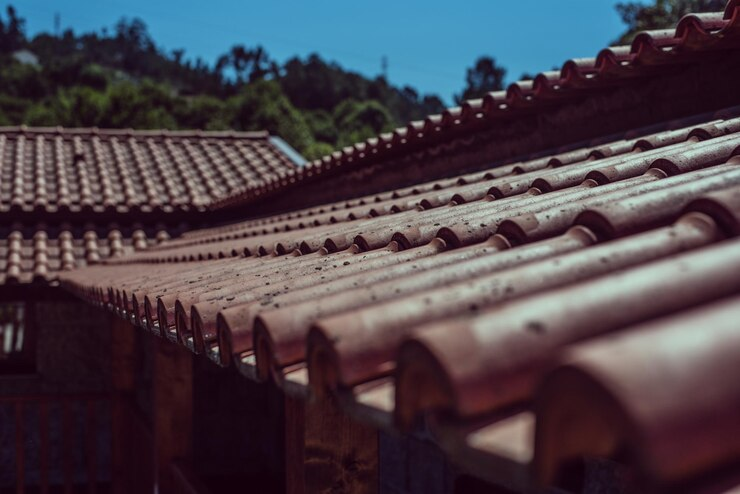
Roofing 101: Understanding The Different Types Of Roofs
Have you ever considered how big an average American house’s roof is? It’s well over 1,600 square feet! That’s bigger than a fair number of apartments!
Table Of Content
- ✅ Understanding Roof Components
- ✅ Common Roof Shapes and Styles
- 1. Gable Roof
- 2. Mansard Roof
- 3. Gambrel Roof
- 4. Shed Roof
- 5. Flat Roof
- ✅ Roofing Materials
- 1. Asphalt Shingles
- 2. Metal Roofing
- 3. Tile Roofing
- 4. Slate Roofing
- 5. Wood Shingles/Shakes
- ✅ Factors to Consider When Choosing a Roof
- ✅ Conclusion
A roof is an essential part of every structure, but it normally doesn’t get attention until it causes troubles. Knowing the variety of roofs is key.
It allows house and building owners to decide wise decisions based on weather, funds, and what looks good. Here, we’ll explore the different types of roofs.
✅ Understanding Roof Components

Before exploring the different styles of roofs, grasping the fundamental structure of a roof is crucial. Essentially, a roof comprises of a few primary parts:
- Roof Deck: It’s the solid foundation that bears the whole roof system, typically made from wood, cement, or metal.
- Underlayment: This is a resistant barrier set up between the rooftop base and the external roof material, offering additional security.
- Flashing: These are bits of metal or plastic that seal roof joints. They stop unwanted water seeping around things like chimneys, vents, and other openings in the roof.
- Tiles/Shingles: This is the top layer that safeguards the roof from weather and adds individuality to the building’s appearance.
With White Castle Roofing, you’ll find an expert commercial roofing company. They focus on installing and maintaining all kinds of roofs, guaranteeing your structure is safe from the elements.
✅ Common Roof Shapes and Styles
The shape and style of a roof can highly influence its performance, longevity, and visual allure. These are some prevalent types of roofs:
1. Gable Roof
A gable roof has two sides that slope and join at a central point, creating a triangle appearance on its ends. This simple design is quick to build and does a good job of removing water and snow, which is why many homes prefer it.
2. Mansard Roof
Born in France, the mansard roof features dual slopes on each side. The lower slope is more angled than the top one. This layout grants extra room in the attic, often linked with grand, old structures.
3. Gambrel Roof
Often referred to as a “barn roof,” the gambrel roof showcases two grades on every side. The bottom grade is sharper than the top one. This pattern affords extra space overhead in the loft while keeping a classic, country-style look.
4. Shed Roof
A shed roof is a single, tilted surface. Its lower edge is usually connected to the wall of the building. This basic pattern is commonly used for extra parts of a house, like porches, or separate structures such as sheds and garages.
5. Flat Roof
As it sounds, a flat roof is a level space with barely any tilt. Although they’re not as usual in houses, many businesses favor flat roofs and factory structures due to their convenience and affordable expense.
✅ Roofing Materials

Picking a type of roofing material can largely influence the total expense, lifespan, and look of a structure. Some frequently used roof coverings comprise of:
1. Asphalt Shingles
Asphalt shingles top the list as America’s most popular roofing choice. They strike a good mix of cost-effectiveness, flexibility, and simple setup. Available in all sorts of designs, ranging from classic three-tab to the more trendy architectural versions.
2. Metal Roofing
Metal roofs, crafted out of steel, aluminum, or copper, are famous for lasting a long time, not catching fire easily, and saving energy. People often pick them for homes and businesses alike.
3. Tile Roofing
Tile roofs, usually crafted from concrete or clay, are famous for their long-lasting nature and traditional Mediterranean or Spanish look. They’re commonly seen in hot or warm weather regions and can stand for many years when properly cared for.
4. Slate Roofing
Slate, a fancy roofing material from nature, stands out for its lasting lifespan and distinctive looks. Despite being pricier than other alternatives, these roofs have a lifespan of over 100 years and need little upkeep.
5. Wood Shingles/Shakes
Materials like cedar shingles and shakes, used for wooden roofing, give a cozy, country style feel, though they need more care compared to other choices. These are usually chosen for buildings that have a historic or classic design.
Read Also:- InstaNavigation – Features, Reviews, and Alternatives
✅ Factors to Consider When Choosing a Roof

Selecting a roof for a new structure or swapping out an old one requires careful thought. The region’s climate dictates the decision because weather impacts the type of materials used and the style. For example, areas with heavy snowfall often need roofs with a sharper slope to help shed off the snow.
Moreover, consider these key factors:
- Durability is key; some materials offer better resistance to different weather conditions and environments. Care requirements vary among roof designs; some require special attention.
- Environmental impact is increasingly important for many, considering energy efficiency and material recyclability. The roof’s expected lifespan should also be weighed against its cost.
When choosing, consider the following factors: weather, price, looks, toughness, durability, and environmental impact. It will allow you to pick wisely, mixing what you need now with what will work best in the years to come.
✅ Conclusion
A homeowner must understand the various types of roofs. Gable, hip, flat, or mansard, each roof design offers unique traits and advantages. Understanding roofing basics helps you make smart choices on repairs, makeovers, or building anew.
Remember aspects like weather, cost, and looks as you pick your home’s ideal roof. This knowledge will help you choose the right commercial roofing company to secure your property’s defense and practicality for many future years.





